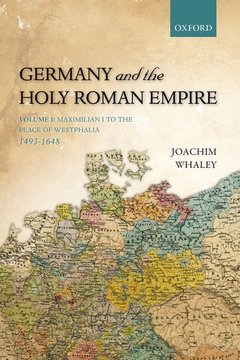Description
Germany and the Holy Roman Empire
Volume I: Maximilian I to the Peace of Westphalia, 1493-1648
Oxford History of Early Modern Europe Series
Author: Whaley Joachim
Language: English
Subject for Germany and the Holy Roman Empire:
Approximative price 207.62 €
In Print (Delivery period: 21 days).
Add to cart
Publication date: 11-2011
752 p. · 16.2x23.8 cm · Hardback
752 p. · 16.2x23.8 cm · Hardback
Description
/li>Contents
/li>Biography
/li>
Germany and the Holy Roman Empire offers a new interpretation of the development of German-speaking central Europe and the Holy Roman Empire or German Reich, from the great reforms of 1495-1500 to its dissolution in 1806 after the turmoil of the French Revolutionary and Napoleonic Wars. Going against the notion that this was a long period of decline, Joachim Whaley shows how imperial institutions developed in response to the crises of the sixteenth and seventeenth centuries, notably the Reformation and Thirty Years War, and assesses the impact of international developments on the Reich. Central themes are the tension between Habsburg aspirations to create a German monarchy and the desire of the German princes and cities to maintain their traditional rights, and how the Reich developed the functions of a state during this period. The first single-author account of German history from the Reformation to the early nineteenth century since Hajo Holborn's study written in the 1950s, it also illuminates the development of the German territories subordinate to the Reich. Whaley explores the implications of the Reformation and subsequent religious reform movements, both Protestant and Catholic, and the Enlightenment for the government of both secular and ecclesiastical principalities, the minor territories of counts and knights and the cities. The Reich and the territories formed a coherent and workable system and, as a polity, the Reich developed its own distinctive political culture and traditions of German patriotism over the early modern period. Whaley explains the development of the Holy Roman Empire as an early modern polity and illuminates the evolution of the several hundred German territories within it. He gives a rich account of topics such as the Reformation, the Thirty Years War, Pietism and baroque Catholicism, the Aufklärung or German Enlightenment and the impact on the Empire and its territories of the French Revolution and Napoleon. It includes consideration of language, cultural aspects and religious and intellectual movements. Germany and the Holy Roman Empire engages with all the major debates among both German and English-speaking historians about early modern German history over the last sixty years and offers a striking new interpretation of this important period. Volume I extends from the late fifteenth century through to the Thirty Years War.
I: Introduction: Narratives of Early Modern German History. II. Germany and the Holy Roman Empire in 1500. 1. Origins and Frontiers. 2. The Reich as a Polity. 3. Fragmented Territories. 4. The Reich and the German Nation. III. The Reform of the Reich and the Church c. 1490-1519. 1. The Reformation Era in German history. 2. The Reich under Maximilian I. 3. Reich, Papacy, and Reichskirche. 4. Religious Renewal and the Laity. 5. Humanism in the Reich. 6. The 'Print Revolution' and the Public Sphere. 7. Economic Landscapes, Communities, and their Grievances. 8. Martin Luther and the 'Luther affair' 1517-19. IV. Charles V and the Challenge of the Reformation in the 1520s. 1. The Reich During the First Decade of Charles V. 2. Luther and Imperial Politics, 1519-1526. 3. Luther and the German Reform Movement. 4. Alternative Reformations and the Dominance of Lutheranism. 5. The Knights' War, 1522-23. 6. The Peasants' War 1525. 7. Reformation in the Cities. V. Mastering the Reformation c. 1526-1555. 1. The Emergence of Protestant Territories. 2. The Persistence of Catholicism. 3. Charles V, Ferdinand, and the Reich in Europe. 4. The Establishment of Protestantism, 1526-1530. 5. The Schmalkaldic League, its Counterparts and the Politics of the Reich, 1530-1541. 6. Charles V as 'Lord of Germany', 1541-58. 7. The Triumph of the Reich, 1548-1555. VI. Managing the Peace 1555-1618. 1. Contours of the 'Confessional Age'. 2. Emperors, Imperial Officials, and Estates after the Peace of Augsburg. 3. Constitutional developments after 1555: Reichstag, Kreise, Courts, and Legislation. 4. The Reich in Europe. 5. Managing the Domestic Peace, 1555-c.1585. 6. The Consensus Falters, c. 1585-1603. 7. Paralysis, 1603-1614. 8. Problems of the Habsburg Dynasty. 9. The Reich in the Reign of Emperor Matthias, 1612-19. 10. The Crisis of the Habsburg lands. VII. The German Territories and Cities after 1555. 1. Problems of Interpretation. 2. A Benign Environment?. 3. State Formation?. 4. Domestic Order and Defence. 5. Confessionalisation?. 6. Finance, Taxation, and Estates. 7. The Resurgence of the Courts. 8. Imperial Cities. 9. Responding to Crises. VIII. The Thirty Years War 1618-1648. 1. The Thirty Years War in German History. 2. What Kind of Conflict?. 3. The Reconquest of Austria and Bohemia, 1618-1623. 4. Ferdinand Victorious. 5. Denmark and the War for the Reich, 1623-29. 6. What Kind of Reich? Sweden and the Defence of German Liberties, 1630-35. 7. Wallenstein and After. 8. France, Sweden, and the German Way, 1635-48. 9. The Peace of Westphalia. 10. The Impact of the War on German Society. 11. The Thirty Years War and the German Polity. Glossary. Abbreviations. Bibliography.
Joachim Whaley read History at Christ's College Cambridge. He held Fellowships in History at Christ's College and Robinson College before becoming a Lecturer in German in the Faculty of Modern and Medieval Languages at Cambridge, where he teaches German history, thought, and language. He is the author of Religious Toleration and Social Change in Hamburg 1529-1819 and of numerous articles on early modern and modern German history. He was elected a Fellow of the Royal Historical Society in 1984, and Fellow of the British Academy in 2015.
© 2024 LAVOISIER S.A.S.

